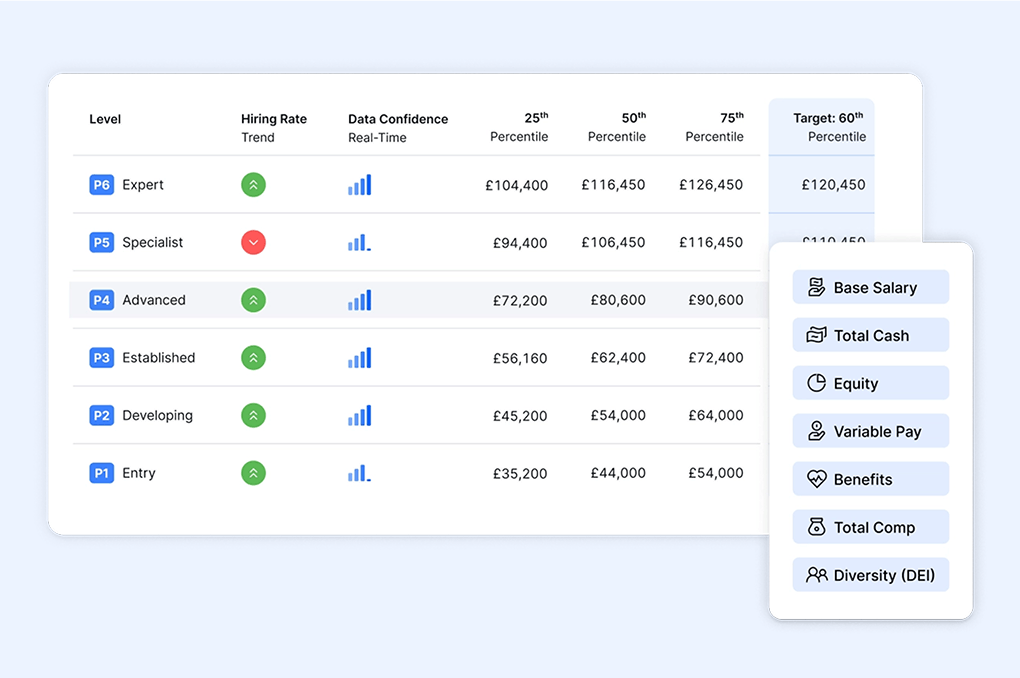Market-based adjustments are a cornerstone of an effective compensation review cycle – ensuring employee pay remains in line with your philosophy on market competitiveness to avoid employee engagement and retention issues.
Indeed, Ravio’s pay review research found that 82% of companies include market adjustments in their compensation reviews.
But for 33% of companies, understanding how market data has changed since their last review ranks as one of the top three most stressful aspects of the entire process.

It’s even more stressful for smaller companies, with 45% of those under 100 employees struggling to track market movements ahead of review cycles.
The challenge becomes clear when we look at how most companies approach market data – and why staying current proves so difficult.
The traditional approach: Outdated survey data is used to inform future compensation adjustments
According to our pay review report, overall, 58% of companies refresh their benchmarking data annually.
This annual benchmarking cadence is especially common for larger companies, with 76% of companies over a 500 headcount refreshing their salary data annually – and these large companies are also more likely to refresh every 2-3 years instead.
When we look at where companies are sourcing their benchmarking data from, we can see that traditional salary surveys – from providers like Radford, Mercer, or Willis Towers Watson – remain a popular source.
Typically, salary surveys work on an annual cycle. Companies self-report their data once a year, it gets collated over several months, so by the time you receive it, the data reflects market rates from at least 6 months ago.
This explains why some HR and Reward teams could be struggling with understanding market changes, when you factor in the time until your next compensation cycle, you could be making market-based adjustments based on data that's 18 months old.
The risks intensify when you consider how fast-moving the talent market in tech can be, like the 578% increase in AI roles and accompanying 10% market premium on new hire salaries in the last few months.
As one Reward Leader told us: "Our compensation reviews are based on old data, because Radford's database tells me the survey results from last year, not what's happening right now. We desperately need better projections or constantly updated benchmarks."
This creates real problems during pay reviews:
- Budget planning becomes guesswork when you don't know how much the market has moved
- You can't confidently tell managers whether their team members are truly at market rate
- Employees lose trust when they discover (through job hunting or peer conversations) that their "market adjustment" left them below current rates.
But companies with the most effective pay review processes are doing something different.
The alternative: Real-time data to stay ahead of market shifts before each compensation cycle (and all year round)
Our pay review research found that companies who rate their process as highly effective (4-5/5) refresh their benchmarking data more frequently.
In fact, they're 1.5x more likely to refresh data quarterly, and a third more likely to refresh biannually.
When it comes to salary reviews, these high-performing teams enter each compensation cycle with current market intelligence.
They know exactly how the market has shifted since their last review, which roles have seen significant movement, and what adjustments are needed to maintain competitive positioning.
It transforms market adjustments from a stress point into a strategic advantage. When you understand current market rates, you can make confident decisions about pay increases that actually keep pace with the market – making proactive discussions about compensation budget plans with your CFO possible, and ultimately protecting both employee engagement and retention.
Making the shift to more current market data doesn't require abandoning your existing processes. Here's how leading teams are implementing this approach.
Add real-time benchmarking data to your comp tech stack
To understand market changes at each compensation cycle, you need access to market data that’s actually current.
The way to achieve that is by using a real-time salary benchmarking tool that connects directly to companies' HRIS systems, meaning benchmarks are updated continuously as pay changes happen.
With Ravio, for instance, you can access continuously updated benchmarks from over 1,400 global tech companies at any time, meaning you always know exactly how the market has moved since your last review.
This shift is already underway.
Our research shows 73% of companies under 100 employees now use real-time compensation data providers, compared to just 27% relying solely on traditional salary surveys.
These newer companies recognise that in today's talent market, annual snapshots simply aren't sufficient for making competitive pay decisions.
💡 The case for combining traditional surveys with real-time data
Our pay review report found that 74% of companies use multiple benchmarking data sources – and there's merit in this approach.
Evert Kraav, Senior Compensation Manager at Bolt, combines traditional salary surveys with Ravio's real-time benchmarking to ensure full coverage for 4,000+ employees across 50+ countries.
The traditional surveys provide established baselines for non-tech roles, while Ravio provides accurate data for tech roles and locations, as well as ensuring the team "sees the impact of big market swings immediately”.
Integrate that real-time data into your compensation cycles
The ideal scenario is to be able to bring that real-time compensation data into your compensation review process – using current market data to refresh your salary bands at the beginning of each review cycle.
When you refresh your benchmarks and bands before you configure your review, they already reflect current market data – which makes it easy to recommend market adjustments.
Plus, during the process, managers see live market positioning for each team member right in their review interface, and can combine this with performance data to ensure fair outcomes – recommendations are grounded in reality, not guesswork.
The result is salary increases that actually reflect market conditions, delivered through a process that's less stressful for everyone involved.
FAQs
Where can I find salary data?
Several sources provide salary data, each with different levels of reliability:
- Government sources: In the UK, sources like ONS and Bureau of Labor Statistics offer aggregated data on typical salary levels
- User-reported sites: Tools like Glassdoor aggregate employee submissions – but these self-reported, historic submissions are not a reliable source
- Job advertisements: Current postings show what companies claim to pay – though ranges are often inflated and offer only one single data point
- Online communities: Reddit and industry forums share anecdotal data
- Salary surveys: Traditional providers like Radford and Mercer offer annual reports via manual submissions of employee data
- Salary benchmarking tools: Real-time platforms like Ravio and Pave pull live data from HRIS systems, ensuring reliable and up-to-date salary data all year round.
For reliable compensation decisions, purpose-built compensation benchmarking companies provide the most accurate, up-to-date data.
What's the best source for UK salary benchmarking data?
The best UK salary benchmarking source provides reliable, relevant, up-to-date data for your specific roles, levels, and locations. For UK tech companies, Ravio offers the most comprehensive coverage with real-time data from 1,400+ companies, including strong representation across London, Manchester, and other UK tech hubs.
Unlike traditional surveys that update annually, Ravio's HRIS and ATS integrations ensure benchmarks reflect current market rates. The platform also provides UK-specific benefits data (pension, private medical insurance, flexible working) alongside base salary and equity, giving a complete total compensation view.
Where can I get free salary benchmarking data?
Free salary benchmarking sources include Glassdoor, Indeed, LinkedIn Salary Insights, and ChatGPT – but these lack verification and often show outdated or skewed data. Job advertisements provide current ranges but typically show inflated upper bounds and offer only a single point of data per ad.
For reliable free options, real-time platforms Pave and Ravio both offer free trials. Ravio provides a 30-day free trial with full access to benchmarking data, allowing you to test whether the dataset covers your roles and locations before committing. This gives you professional-grade data without immediate investment.
What is a compensation cycle?
A compensation cycle (or compensation review cycle) is the regular process companies use to review and adjust employee salaries. Most companies run annual cycles, though some review compensation bi-annually or quarterly.
Each cycle typically includes refreshing market data, evaluating employee performance and progression, setting budgets, and implementing pay adjustments. The goal is ensuring compensation stays competitive with market rates whilst rewarding performance and maintaining internal equity – to aid employee engagement and retention.
What is the annual merit cycle?
An annual merit cycle is a specific type of compensation review that incorporates employee performance into pay decisions (in a ‘pay for performance’ model). Unlike general compensation reviews that might only address market adjustments, merit cycles directly link salary increases to performance ratings.











